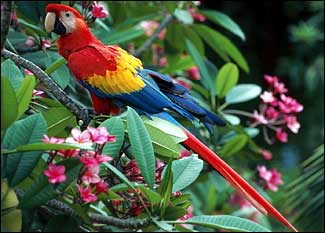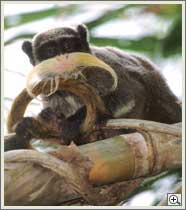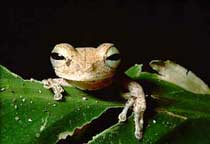Note: We require minimum two passengers traveling together If single traveler ask for the supplement.
The Newest Manu Adventurer
Manu National Park and Manu Wildlife Center
By commercial flight Cusco/Puerto Maldonado/Cusco
Duration:
5 days/4 nights
This itinerary offers the complete lowland rainforest experience, taking us by air and then motorized canoe to Manu Wildlife Center, This lodge is located east of the Manu River on the north bank of the Madre de Dios River and offers the Amazon’s finest, in-depth wildlife safari. The lodge is famous for its abundant and varied wildlife, with its own Tapir clay lick, a nearby macaw and parrot clay lick, two nearby oxbow lakes and two tall canopy viewing towers among its impressive highlights. The Lodge contains 22 double-occupancy fully screened private bungalows with hot showers, a large fully screened dining room, and a bar with hammocks for relaxing with the comfort of the our Amazon’s finest wildlife lodge, next day in our rustic, Manu Wildlife Tented Camp in the heart of the Manu Biosphere Reserve.
Only 20% of the entire Amazon has rich, floodplain soils that produce high yields of rainforest fruits, and therefore support dense populations of monkeys, macaws, and all other vertebrates and invertebrates. Of this 20%, ONLY ONE PERCENT is both protected by biological reserves AND has regular jet or turboprop flights. Manu Wildlife Center is the finest lodge in that “one percent of 20%” – which explains why Condé Nast Traveler Magazine found it to be “the most intense wildlife experience in Amazonia”.
Manu National Park, Amarakaeri Communal Reserve, Manu Wildlife Center Private Reserve, and Los Amigos Private Reserve comprise a single, continuous complex of protected areas in Manu province —the best protected section of the one percent of the 20%. The oldest of these units, Manu National Park, boasts the coveted status of UNESCO World Heritage Site. The entire complex covers 2.5 million hectares/6.2 million acres, almost the size of Belgium or the U.S. state of Maryland. The region includes vast areas inhabitated only by either uncontacted tribes or a handful of intrepid scientists.
In this vast area we find 1,000 of the globe’s 10,000 bird species (200 more than all of the U.S. and Canada combined), 15,000 of the world’s 250,000 flowering plant species, and hundreds of Jaguars. To put all of this in conservation perspective, this protected area is TWICE AS LARGE as all Costa Rican reserves —in fact, fully half the size of ALL of Costa Rica.
In Manu we navigate the waters of an isolated oxbow lake, home to Giant Otters, caimans, monkeys and an endless variety of birds. Our trip ends downriver with the Amazon’s finest wildlife viewing opportunities, at Manu Wildlife Center. This lodge offers the finest Tapir viewing in ALL the Amazon, as Tapirs are nightly visitors to the lodge’s mud wallow. After a canoe and van journey we return to Cusco aboard in a commercial flight.
| Duration | 5 days and 4 nights |
| Departures | Thursdays |
| Activities | Jungle excursion (see detailed program below) |
| Meals | included as specified below |
| Customizable | YES, feel free to ask for extra services |
DAY 1: MANU WILDLIFE CENTER
Upon arrival to Puerto Maldonado you will be transfer by van to Santa Rosa Village we will get there in about three hours journey aprox., we will cross the Inambari river for a 15 minutes by boat, then we have one hour more by car from this place to the Boca Colorado Village, followed by 03 hours motorized boat journey ride upstream the Madre de Dios river in between we plan on a delicious boxed lunch at the beginning of the boat journey to Manu Wildlife Center.
After dinner there will be an enchanting night walk along the trails, in search of the nocturnal birds and animals of the rainforest. (Box Lunch, D)
DAY 2: MANU WILDLIFE CENTER: THE MACAW CLAYLICK, AND AND MANU NATIONAL PARK (MANU WILDLIFE TENTED CAMP)
Another early start (inevitable on wildlife expeditions), is followed by a short boat ride downstream. We take a 20-minute trail through palm plantations to a cut-off channel of the river, where we find the Macaw Lick. A spacious hide provided with individual chairs and a convenient place for cameras and binoculars is our ringside seat for what is usually a very spectacular show. We enjoy a full breakfast here while waiting for the main actors to arrive.
In groups of twos and threes the big Red-and-Green Macaws come flapping in, landing in the treetops as they eye the main stage below —the eroded clay banks of the old channel. Meanwhile the supporting cast appears: these may included Blue-headed, Mealy, Yellow-crowned, and Orange-cheeked Parrots— and the occasional villain, a menacing and unwelcome Great Black Hawk.
The drama plays out in first in tentative and then bolder approaches to the lick, until finally nearly all the macaws, parrots and parakeets form a colorful and noisy spectacle on the bare banks, squabbling as they scrape clay from the hard surface.
(Please note that the clay lick is most active from August to October and less so during the months of May and June.)
Around 9:30 am begin our boat journey in the motorized canoe trip up the Madre de Dios River, after reaching the village of Boca Manu and the turbulent union of the Alto Madre de Dios and Manu Rivers we check into the park at Limonal ranger station and then proceed upstream, as our boat driver steers skillfully through shallows and driftwood snags. Orinoco Geese and Horned Screamers strut on the beaches, Capped and White-necked Herons patrol the shoreline, and countless sunbathing turtles dive off their log perches as we approach, into the lake-rich lower Manu River of the Manu National Park. The pristine quality of the forest is instantly apparent, with abundant birdlife and no signs of outside development.
After some seven hours on the river we reach InkaNatura’s Manu Tented Camp, a simple but comfortable, low-impact lodge nestled almost invisibly in the forest.
Time permitting, we will take a short walk before dinner to stretch our legs and enjoy our first encounter with virgin rainforest. (B, Box Lunch, D)
DAY 3: MANU NATIONAL PARK (MANU WILDLIFE TENTED CAMP): COCHA SALVADOR & COCHA OTORONGO
Today we visit two lakes near our camp. Park authorities determine the time of our visit to Cocha (Lake) Salvador; depending on this schedule, we will visit Cocha Otorongo earlier or later in the day.
Our trail to Cocha Otorongo begins some 30 minutes downstream from the camp. This brief river journey to the trailhead can always offer the chance of a thrilling wildlife sighting. Perhaps we will spot a family of capybaras, the world’s largest rodent, looking like giant Guinea Pigs as they browse on the riverbank, or if we are very lucky, a solitary jaguar might stalk slowly off an open beach into the forest, flicking its tail in annoyance at our intrusion.
On the short trail to the lake we may spy one or more of the park’s 13 monkeys species leaping through the canopy high above. And some of the trees which form that canopy —such as kapok, ironwood and figs, will astound us with the vast size of their trunks and buttressed root systems.
These are oxbow lakes, formed when the river changed course, leaving a landlocked channel behind. The lakes are abundant in fish and wildlife, and provide optimum habitat for caimans and the Giant Otter (Pteronura brasiliensis), one of the Amazon’s most endangered mammal species. This lake enjoys maximum protection, and boats are not allowed. However, it features two dock platforms and a 50ft tower from which to scan the trees and marshy shoreline for monkeys, kingfishers, Anhinga (a large, long-necked waterbird), and countless other species. We have a good chance of sighting the resident Giant Otter family as they dive for the 4Kg. of fish that each individual consumes daily.
Cocha Salvador is the largest of the area’s lakes, at 3.5 Km, or some two miles long. It is also home to a family of Giant Otters. We cruise the lake on a floating catamaran platform, which offers superb new perspectives of lake and forest. The lakeside trees are often alive with monkeys; Scarlet, Chestnut-fronted and Blue-and-gold macaws beat a path overhead; a variety of herons and egrets scout the water’s edge; and the reptilian eyes and snouts of caimans, motionless as logs, may be spied beneath the branches. Somewhere on the open water or in among toppled bankside trees, we may spot the sleek heads of the shy Giant Otters. These social animals play and fish together, and we may see them sprawled on a fallen tree trunk, dozing or gnawing on a fish. (B, L, D)
DAY 4: MANU NATIONAL PARK (MANU WILDLIFE TENTED CAMP) TO MANU WILDLIFE CENTER TAPIR CLAYLICK.
We set off downriver at dawn. At this hour chances of wildlife encounters are excellent. We return to the Limonal park station, to file our wildlife report before leaving the park. After reaching the turbulent union of the Alto Madre de Dios and Manu Rivers and then the village of Boca Manu, we may drop off some passengers returning to Cusco. After ninety more minutes downstream we arrive at Manu Wildlife Center —the exciting final stop of our journey— in time for lunch.
In the afternoon we make our first acquaintance with the rainforest, exploring some of the 30 miles of forest trails that surround the lodge. We have an excellent chance of encountering some of the 12 species of monkeys, including the Spider Monkey and Emperor Tamarin, which inhabit the surrounding forest, later we set off along the “collpa trail”, which will take us to the lodge’s famous Tapir Clay lick. Here at the most active tapir lick known in all the Amazon, our research has identified from 8-12 individual 600-pound Tapirs who come to this lick to eat clay from under the tree roots around the edge. This unlikely snack absorbs and neutralizes toxins in the vegetarian diet of the Tapir, the largest land animal of Latin America. The lick features a roomy, elevated observation platform 5 m/17 ft above the forest floor. The platform is equipped with freshly-made-up mattresses with pillows. Each mattress is covered by a roomy mosquito net. The 50-m-long, elevated walkway to the platform is covered with sound-absorbing padding to prevent our footsteps from making noise. This Tapir Experience is unique and exciting because these normally very shy creatures are visible up close, and flash photography is not just permitted, but encouraged.
The hard part for modern city dwellers is to remain still and silent anywhere from 30 minutes to two or more hours. Many prefer to nap until the first Tapir arrives, at which point your guide gently awakens you to watch the Tapir 10-20 m/33-66 ft) away below the platform. Most people feel that the wait is well worth it in order to have such a high probability of observing the rare and elusive Tapir in its rainforest home. (B, L, D).
DAY 5: MANU WILDLIFE CENTER TO CUSCO – DEPARTURE DAY
We leave our lodge very early on the three-hour return boat trip downstream to the Colorado Village, the breakfast will be serve on the boat while you enjoying early morning wildlife activity as we go, of course this is a perfect time to take advantage of valuable early morning wildlife activity along the river, in aditions this journey allows us to see several lowland native settlements and gold miners digging and panning gold along the banks of the Madre de Dios River. We will stop in the far-west type gold-mining town of Colorado to start our overland journey to Puerto Maldonado. A van or bus will drive us to the airport in Puerto Maldonado, in approximately four-hours more, From here you fly to Cusco or Lima (airfares not included) (B)
Important notes:
Please note that the program may vary slightly so as to maximize your wildlife sightings, depending on the reports of our researchers and experienced naturalist guides based at the lodge.
END OF OUR SEVICES



INCLUDES:
All hotel and lodge accommodations based on double or single occupancy. All scheduled land, lake and river transportation. All transfers. All scheduled excursions with English-speaking guide services. All entrance fees. Meals as specified in the itinerary. B=Breakfast; L=Lunch; D=Dinner.
NOT INCLUDED IN THE FEE
International or domestic airfares, airport departure taxes or visa fees, excess baggage charges, additional nights during the trip due to flight cancellations, alcoholic and non-alcoholic beverages or bottled water, snacks, insurance of any kind, laundry, phone calls, radio calls or messages, reconfirmation of international flights and items of personal nature.




